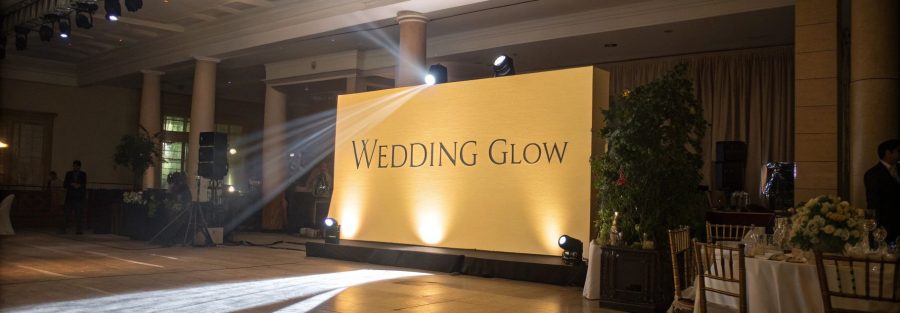Set the Mood with the Perfect Wedding Uplighting
Transform your wedding venue with strategic uplighting. This list explores eight impactful uplighting ideas to elevate your celebration. Discover how color, patterns, and placement can create the perfect atmosphere, whether you envision a romantic glow or a vibrant party. From simple color washes to custom projections, find the ideal uplighting to enhance your décor and create a memorable experience.
1. Color-Matching Uplighting
Color-matching uplighting is a powerful technique that can transform any wedding venue into a cohesive and visually stunning space. It involves strategically placing lighting fixtures around the perimeter of the room and angling them upwards to wash the walls and architectural features in a specific hue. The key to this technique is precisely matching the lighting color to your wedding's color palette, creating a harmonious blend between the lighting and other décor elements like floral arrangements, linens, and even the bridesmaids' dresses. This creates an immersive environment that reflects your personal style and enhances the overall aesthetic of your celebration.
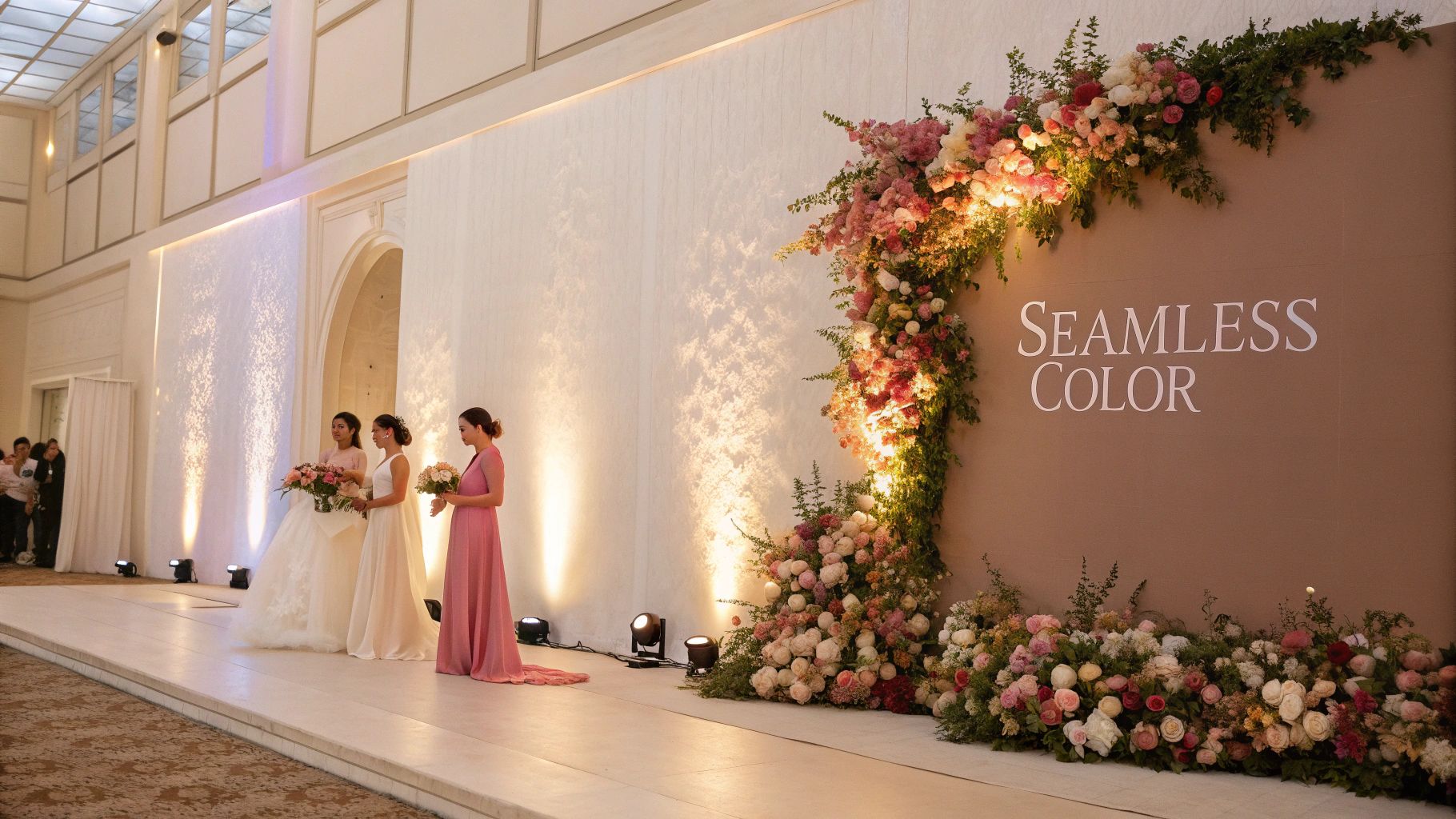
Typically, this method utilizes RGB LED fixtures, which offer a vast spectrum of colors and allow for precise color matching. These fixtures are usually placed around the perimeter of the venue, aiming upwards towards walls, columns, or other architectural details. For an average-sized venue, 10-20 fixtures are often sufficient to achieve a noticeable and impactful effect. The lights can be programmed to maintain static colors throughout the event, ensuring a consistent ambiance.
A classic example of color-matching uplighting is pairing a soft dusty rose lighting with dusty rose floral centerpieces and bridesmaids' dresses. This creates a romantic and unified look. Venues like The Langham Hotel in Chicago are renowned for their masterful use of color-matched lighting in creating breathtaking wedding settings. This technique doesn't just apply to weddings. Corporate event managers can use it to reinforce brand colors, while private party hosts can create a mood that perfectly complements their chosen theme.
Why choose color-matching uplighting?
- Cohesive Aesthetic: It ties all your design elements together, creating a visually harmonious environment.
- Venue Transformation: It can dramatically enhance even the plainest venues, adding depth and personality without needing extensive decorations.
- Enhanced Photography: Color-matched lighting creates a beautiful backdrop for photos, ensuring your wedding pictures look stunning.
- Personalized Atmosphere: It allows you to truly personalize your event space and reflect your unique style.
Pros:
- Creates a cohesive aesthetic that ties together all design elements
- Transforms plain venues into personalized spaces
- Photographs exceptionally well, enhancing wedding photos
- Can dramatically change the appearance of a venue without excessive additional decorations
Cons:
- Requires knowing your exact color palette in advance
- Some colors (particularly pastels) can be difficult to reproduce exactly in lighting
- May increase your overall lighting budget
Tips for Success:
- Provide Swatches: Give your lighting designer physical color swatches instead of just color names to ensure the most accurate match.
- Test the Lighting: Schedule a lighting test before your event to see how the colors look in the actual venue and make adjustments as needed.
- Consider Photography: Remember that some colors photograph differently than they appear in person. Test how your chosen colors look in photos during your lighting test.
- Lighting Gels: For conventional fixtures, consider using high-quality lighting gels for more precise color matching.
Color-matching uplighting is a valuable tool for anyone looking to elevate their event. By carefully selecting colors and working with a skilled lighting professional, you can transform your venue and create a truly unforgettable atmosphere. Its ability to seamlessly blend with other décor elements, enhance photography, and personalize the space makes it a worthwhile investment for weddings, corporate events, and any special occasion.
2. Dynamic Color-Changing Uplighting
Dynamic color-changing uplighting is a transformative lighting technique that uses programmable LED fixtures to wash your venue in a spectrum of colors. Unlike static uplighting, which remains a single color, these intelligent lights gradually shift between hues throughout the event. This creates a dynamic atmosphere that evolves with the celebration, seamlessly transitioning from a soft, romantic glow during dinner to vibrant, energetic shades for the dance floor.
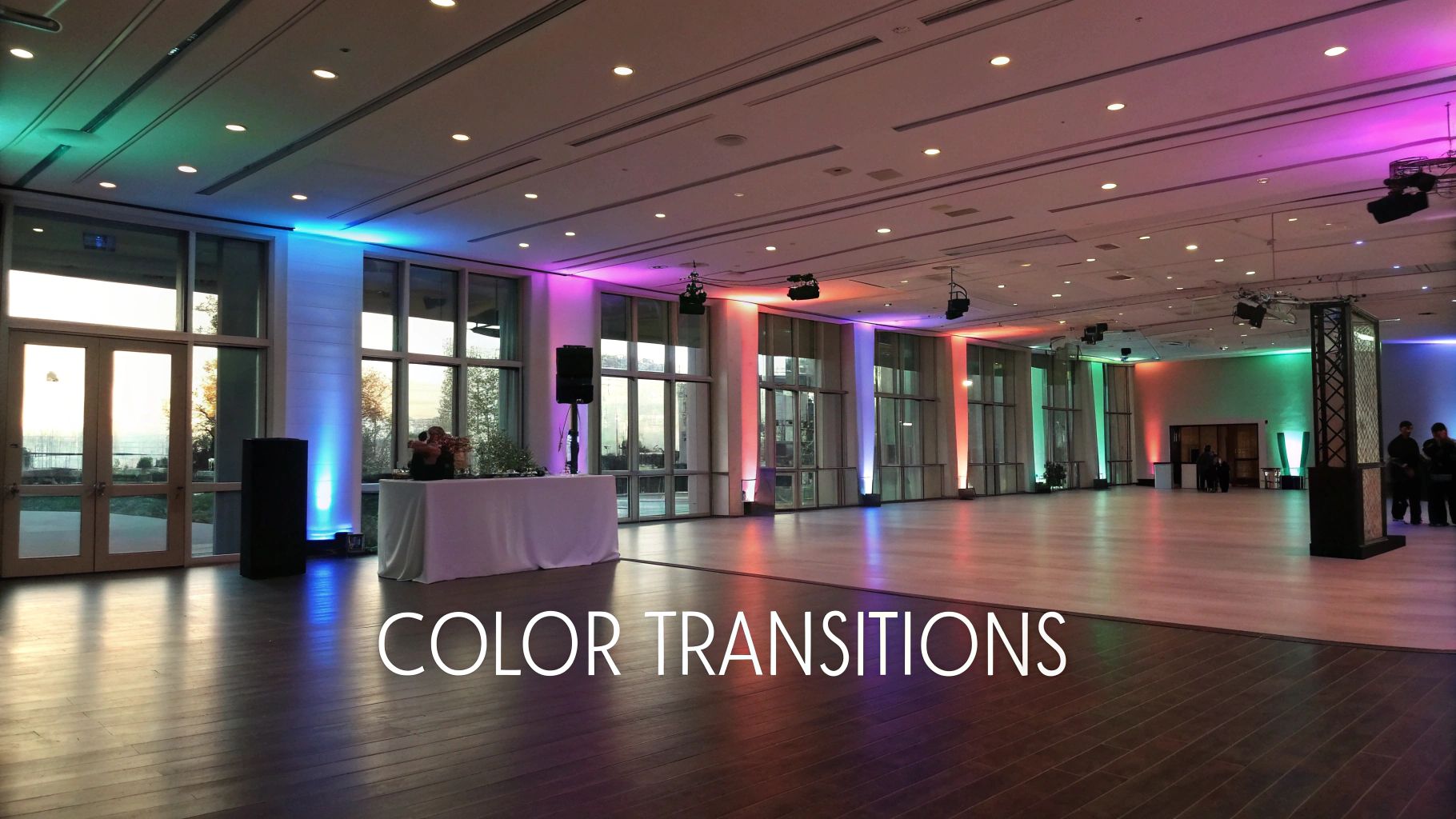
The magic of dynamic uplighting lies in its programmability. Modern systems offer precise control over color transitions, allowing for subtle shifts over several minutes or dramatic, instantaneous changes. DMX-controlled systems can even synchronize the lighting with your music playlist or event schedule, creating breathtaking visual displays timed perfectly with key moments like the first dance or cake cutting. Furthermore, you can create room-wide color washes or focus on specific areas, highlighting architectural features or décor elements. Many systems now offer wireless control via tablets or smartphones, giving you ultimate flexibility and control. Learn more about Dynamic Color-Changing Uplighting
The benefits of dynamic color-changing uplighting are numerous. It adds significant visual interest throughout the event without the need for extensive (and expensive) decorations. It seamlessly guides the mood of the celebration, effortlessly transitioning from the ceremony to cocktail hour, dinner, and finally, the energetic dance party. Beyond mere illumination, it becomes an entertainment element, enhancing the overall guest experience. For example, The Plaza Hotel in NYC uses sophisticated color-changing systems, subtly shifting from a warm golden amber during dinner to cool blues and purples for dancing. Even high-profile events, like the Kardashian-West wedding, have showcased the dramatic impact of color transitions synchronized with music.
While the potential for dynamic lighting is vast, there are some considerations. These systems are more complex to program and often require technical expertise. Rental costs are typically higher than static lighting options. If not programmed carefully, rapid or jarring transitions could be distracting rather than enhancing.
For couples planning weddings or anyone organizing a special event, dynamic uplighting offers an unparalleled level of control and creativity. To maximize its impact, program slow, subtle transitions (generally 5+ minutes per change) for a more elegant feel. Create a lighting schedule that aligns with your reception timeline and consider using color psychology: warm colors for intimate moments and cool colors for a lively party atmosphere. If your budget allows, hiring a dedicated lighting technician to manage the transitions is highly recommended. If you’re looking for ways to create a truly immersive environment, consider incorporating other elements of dynamic lighting design, such as moving heads, projections, or interactive displays. This approach, popularized by wedding designers like Preston Bailey, uplighting providers like UplightingAmerica, and DJ companies offering integrated music and lighting packages (like Elite Entertainment), can transform your venue into a truly captivating space.
3. Pattern Projection Uplighting
Pattern projection uplighting elevates basic uplighting to an art form. Instead of simply washing walls with color, this technique uses gobo projectors or specialized pattern systems to cast custom designs, monograms, or textured patterns onto surfaces like walls, ceilings, and dance floors. This adds another layer of visual interest, creating depth, personalization, and a truly memorable atmosphere. Transform a plain ballroom into a magical wonderland or project your intertwined initials onto the ceiling for a touch of personalized romance. Pattern projection uplighting allows you to brand your event, enhance your venue's architecture, or simply add a "wow" factor that guests will remember.
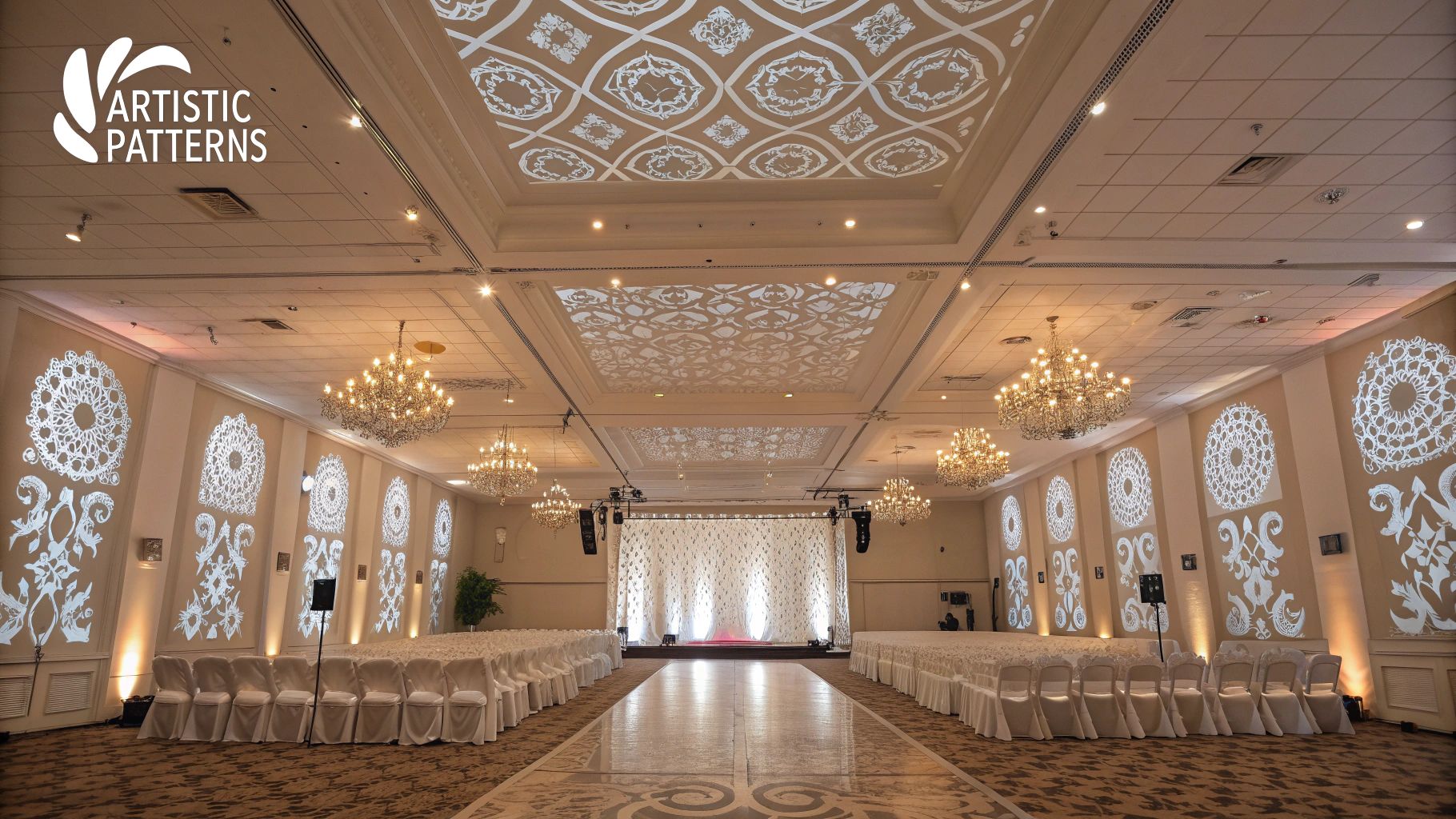
This method offers a wide range of creative possibilities. Project your wedding date, a meaningful symbol, or custom artwork. Choose from pre-designed patterns like elegant damask, modern geometric shapes, or nature-inspired elements like leaves or branches. Static projections create a constant visual element, while rotating or moving patterns add dynamic energy, particularly effective for dance floors. Combining pattern projection with colored lighting further enhances the effect, allowing you to match your wedding colors or create a specific mood.
Examples of Successful Implementation:
- The Plaza Hotel, New York: Known for its iconic ceiling washes, The Plaza often incorporates custom monogram projections, adding a touch of personalized elegance to weddings and galas.
- The Breakers Palm Beach: This luxury resort utilizes pattern projection to accentuate the intricate details of its ceiling architecture, creating a breathtaking visual experience.
When and Why to Use Pattern Projection Uplighting:
Pattern projection uplighting is ideal for adding a unique, personalized touch to any event, from weddings and corporate galas to private parties and charity events. It's particularly effective in venues with high ceilings or large, blank wall spaces. Consider using this technique to:
- Personalize your event: Project monograms, names, dates, or meaningful symbols.
- Enhance your venue: Complement existing architecture with subtle patterns or create a dramatic transformation with bold designs.
- Create a specific mood: Use patterns and colors to evoke a sense of romance, elegance, or excitement.
- Make a statement: A striking projection on the dance floor or ceiling can serve as a focal point and create a memorable photo opportunity.
Tips for Success:
- Simplicity is key: Keep monogram designs simple and high-contrast for optimal visibility.
- Complement, don't compete: Choose patterns that enhance, not clash with, your venue's existing decor.
- Consider viewing angles: Ensure projections are visible from all guest vantage points.
- Test in advance: Project your chosen patterns beforehand to ensure they appear as intended and don't appear too busy or distorted.
- Order gobos early: Custom gobos typically require 2-3 weeks lead time.
Pros:
- Highly personalized and unique visual elements
- Adds texture and dimension to plain surfaces
- Incorporates meaningful symbols and designs
- Creates dramatic impact in photos
Cons:
- Custom gobos require advance ordering (2-3 weeks)
- More expensive than basic uplighting
- Requires precise positioning and focusing
- Some venues may have restrictions on projection use
This technique earns its place on this list because it offers an unparalleled level of customization and visual impact. Pattern projection uplighting goes beyond basic illumination, transforming your event space into a canvas for personalized artistry. While requiring a bit more planning and investment, the results are undeniably worth it for those seeking a truly unforgettable experience.
4. Architectural Accent Uplighting
Architectural accent uplighting elevates a venue's inherent beauty by strategically illuminating its structural features. Instead of washing entire walls with color, this technique uses precisely positioned, narrow-beam fixtures to highlight specific elements like columns, archways, alcoves, intricate moldings, or unique architectural details. It creates depth and dimension, drawing the eye to the venue's most striking features and transforming its ambiance.
This approach differs from general uplighting by focusing on precision and subtlety. Rather than flooding the space with color, it often employs white or warm amber light to complement the existing décor and enhance the natural materials of the venue. Varying intensities can further create a visual hierarchy, emphasizing certain features over others.
Examples of Successful Implementation:
- Historic Churches: Imagine the Gothic arches at St. Augustine's Church highlighted with warm amber uplights, adding a touch of reverence and drama to the ceremony.
- Grand Venues: Picture the Chicago Cultural Center's Tiffany dome accentuated with specialized architectural lighting, showcasing its intricate design and vibrant colors.
- Stately Homes: Envision the columns at the Biltmore Estate illuminated to emphasize their grandeur and create a sense of timeless elegance.
Why Choose Architectural Accent Uplighting?
This technique is ideal for couples and event planners who want to:
- Showcase the venue: If you've chosen a location with stunning architecture, this lighting style is the perfect way to make it the star of the show. It minimizes the need for excessive decorations, letting the venue's inherent beauty shine.
- Create a sophisticated atmosphere: Architectural accent uplighting produces a refined and elegant ambiance without looking overly "themed" or colorful.
- Capture stunning photographs: The interplay of light and shadow created by this technique provides dramatic backdrops for unforgettable photos.
Pros:
- Enhances the venue's natural beauty and architectural features
- Creates a sophisticated, elegant ambiance
- Photographs exceptionally well
- Can reduce the need for additional decorations
Cons:
- Requires detailed venue knowledge and a pre-event site visit for optimal planning.
- More labor-intensive to set up correctly due to the precise positioning required.
- Some historic venues may have restrictions on mounting or positioning lights.
Tips for Implementation:
- Night Visit: Walk the venue at night before finalizing your lighting plan to identify key architectural elements and assess existing lighting conditions.
- Fixture Power: Use higher-powered fixtures for tall ceilings or distant features to ensure adequate illumination.
- Color Temperature: Consider color temperature carefully. Warmer lights (amber, gold) enhance the beauty of stone and wood, while cooler lights might be more suitable for modern venues.
- Glare Avoidance: Position lights strategically to avoid glare for seated guests.
Popularized By: Pioneers like Bentley Meeker Lighting & Staging have elevated architectural accent uplighting to an art form. Features in publications like Architectural Digest and specialists in historic venue lighting, such as Weddings at Blenheim Palace, further demonstrate the impact and popularity of this technique.
Architectural accent uplighting deserves a place on this list because it offers a unique and powerful way to transform a venue. By focusing on precision and subtlety, it creates an atmosphere of elegance and sophistication that complements, rather than overwhelms, the event's overall design.
5. Garden and Outdoor Uplighting
Garden and outdoor uplighting dramatically extends the wedding ambiance beyond indoor spaces, transforming ordinary gardens and outdoor areas into truly magical settings. This technique involves strategically placing weatherproof lighting fixtures to illuminate trees, shrubs, pathways, water features, and other natural elements. By highlighting the existing beauty of the outdoor environment, uplighting creates a captivating atmosphere for evening ceremonies, receptions, and post-sunset photography. Learn more about Garden and Outdoor Uplighting
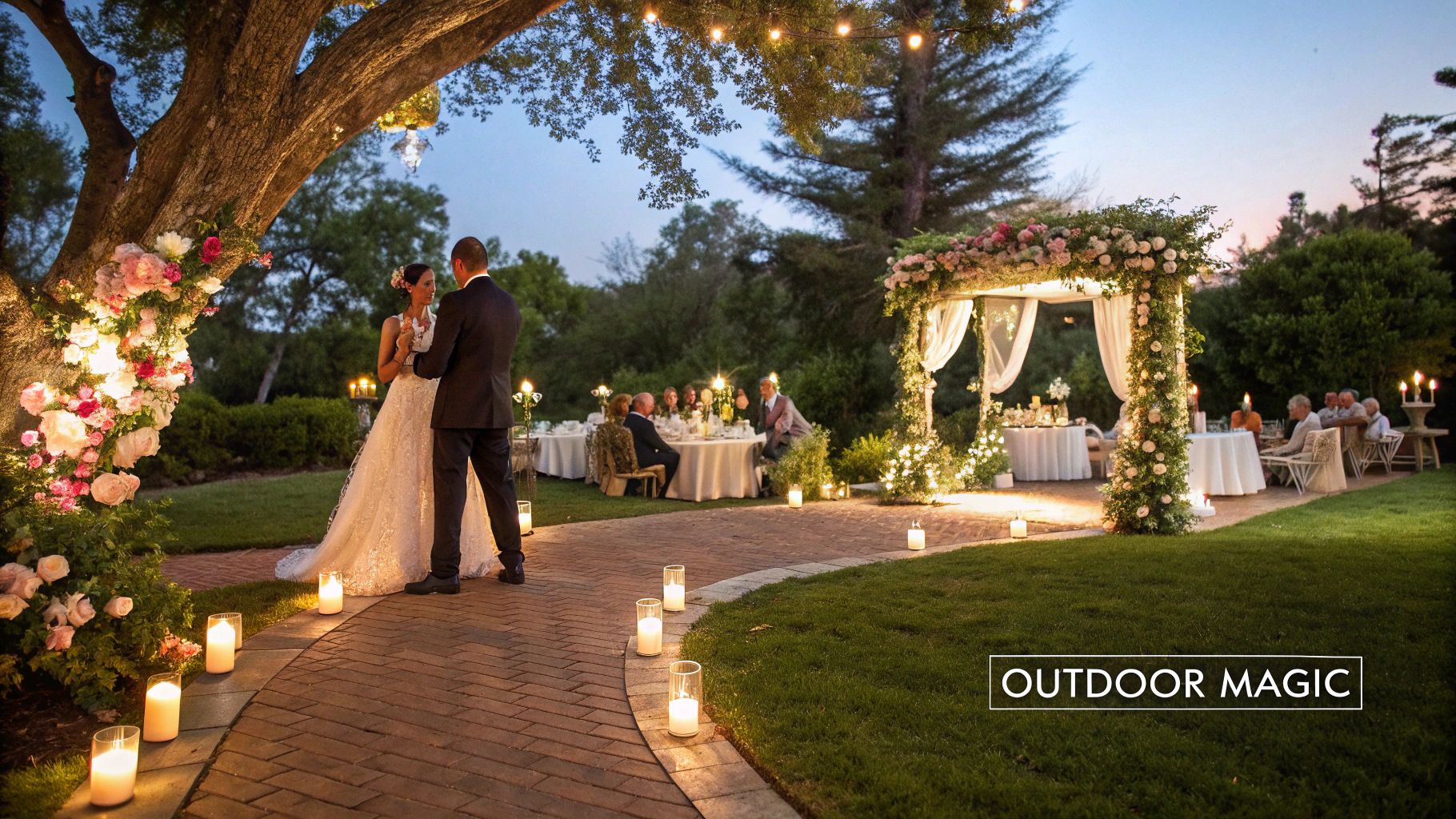
This approach deserves its place on this list because it significantly enhances the visual appeal and functionality of outdoor event spaces. Utilizing IP-rated weatherproof fixtures, often available in solar or battery-powered options for off-grid areas, allows for versatile placement and minimizes logistical challenges. Warm white and amber tones are typically favored for enhancing the natural beauty of foliage and architectural details, while varied beam spreads cater to different sized elements. The famous gardens at Filoli Historic House & Garden, with their century-old trees illuminated through uplighting, exemplify the breathtaking impact of this technique. Similarly, the comprehensive garden lighting designs used for evening events at the New York Botanical Garden showcase the transformative power of outdoor uplighting.
Tips for Effective Garden and Outdoor Uplighting:
- Dramatic Canopy Effects: Position uplights at the base of mature trees to create dramatic washes of light on the canopy.
- Realistic Moonlight on Water: Use cooler white lights for water features to mimic the reflective qualities of moonlight.
- Test During Daylight: Install and test the lighting several hours before sunset to ensure optimal positioning and desired effects.
- Seasonal Considerations: Account for seasonal changes in foliage density and light penetration when planning your lighting design.
- Secure Placement: Use staked fixtures that can be securely positioned in the soil, especially in areas with potential foot traffic.
Pros:
- Enchanted Atmosphere: Transforms ordinary gardens into enchanting, magical spaces.
- Stunning Photography Backdrops: Creates captivating backdrops for outdoor photos after sunset.
- Extended Event Space: Extends the usable event space into the evening hours.
- Improved Safety: Illuminates walkways and steps, enhancing safety for guests.
Cons:
- Weather Dependency: Requires contingency plans in case of inclement weather.
- Power Requirements: Needs outdoor power sources or battery/generator solutions.
- Complex Installation: Can be more complex to install in natural settings.
- Potential for Increased Cost: May increase setup time and overall cost.
By carefully considering these features, benefits, and potential challenges, event planners can leverage the power of garden and outdoor uplighting to create truly unforgettable and visually stunning events.
6. Ambient Uplighting for Tents and Draping
Ambient uplighting for tents and draping is a transformative lighting technique that uses strategically placed fixtures to illuminate fabric surfaces. This creates a soft, diffused glow that envelops the entire space in a flattering light, turning ordinary tents and drapes into stunning design elements. By washing the fabric with light, this method adds depth, color, and a touch of magic to any event.
How it Works:
The concept is simple yet effective. Lighting fixtures are positioned either at the perimeter of a tent, pointing upwards to illuminate the walls and ceiling, or placed behind draped fabric to create a backlit effect. Often, multiple fixtures at varying heights are used to achieve a uniform and immersive glow. The light filters through the fabric, creating a warm, inviting ambiance. This technique works particularly well with translucent or semi-translucent fabrics, allowing the light to permeate and create a captivating effect.
Examples of Success:
Think of Chelsea Clinton's wedding in Rhinebeck, NY, where a fully illuminated tent ceiling created a breathtaking atmosphere. Or envision the iconic Hamptons tented weddings orchestrated by planner Marcy Blum, where ambient lighting plays a crucial role in setting the mood. These high-profile examples demonstrate the transformative power of this technique.
Why Choose Ambient Uplighting for Tents and Draping?
This method is ideal for creating a cohesive and immersive atmosphere. It transforms basic white tents into colorful or elegantly understated environments, offering a versatile backdrop for any celebration. Ambient uplighting also provides general lighting while simultaneously serving as a decorative element. This is particularly beneficial for photography, creating a "glowing" background that enhances every shot.
Pros:
- Creates an immersive, cocoon-like atmosphere.
- Transforms basic white tents into colorful or elegant environments.
- Provides general ambient lighting while still appearing decorative.
- Particularly effective in photos, creating a 'glowing' background.
Cons:
- Requires careful placement to avoid hot spots or dark areas.
- Heat management needed with traditional fixtures (LED preferred).
- Effectiveness varies based on fabric opacity and color.
Actionable Tips:
- Placement is Key: Position lights far enough from the fabric to avoid creating visible hot spots. Aim for an even distribution of light.
- Go LED: Use LED fixtures to minimize heat concerns near fabrics. LEDs are also more energy-efficient and offer a wider range of color options.
- Fabric Testing: Test the lighting with the exact fabric that will be used, as opacity significantly affects light diffusion.
- Color Considerations: Consider how the fabric color will influence the perceived light color. White fabrics offer the truest color representation, while colored fabrics will tint the light.
- Pole Tent Emphasis: For pole tents, consider using uplighting on the poles themselves for added structural emphasis.
Popularized By:
Pioneers like tent company Raj Tents, known for their signature colored tent lighting, event designer David Stark, and draping specialist Revelry Event Designers have helped popularize this trend, demonstrating its versatility and impact.
Ambient uplighting for tents and draping deserves its place on this list because it offers a powerful way to transform a space. By thoughtfully combining lighting and fabric, you can create a truly unforgettable ambiance for any event, from intimate gatherings to grand celebrations.
7. Uplighting with Intelligent/Moving Fixtures
For those seeking to transform their wedding reception into a truly unforgettable spectacle, intelligent/moving fixture uplighting offers unparalleled dynamism and visual impact. Unlike traditional static uplighting, these automated, programmable fixtures can change color, position, pattern, and beam characteristics throughout the event. This allows for a lighting design that evolves with the celebration, shifting from subtle wall washes during dinner to energetic, movement-filled effects during dancing.
How does it work? Each fixture is motorized, offering pan and tilt capabilities, alongside color-changing, zoom, and focus features. These features are controlled through pre-programmed sequences that can be synchronized with music or a specific timeline. The versatility extends to multiple beam and gobo (template) options within a single fixture, creating a wide array of effects.
The benefits of this technology are significant. It creates high-impact, memorable lighting experiences that can truly elevate the atmosphere. The multi-purpose nature of these fixtures also reduces the overall number needed, potentially streamlining setup and logistics. Intelligent lighting facilitates seamless transitions between different phases of the event, effortlessly adapting the ambiance from a sophisticated dinner setting to a vibrant dance floor. For the reception, it can even create a concert-like atmosphere, guaranteeing a lively and engaging celebration. Think of the stunning visuals at high-end destination weddings like those at Atlantis Bahamas, which utilize professional moving light systems, or the synchronized intelligent lighting that enhanced Priyanka Chopra and Nick Jonas's wedding reception.
However, this advanced technology comes with certain considerations. The cost is significantly higher than static lighting, and it requires professional programming and operation. The fixtures themselves can be more visually intrusive than traditional uplights, and the dynamic nature of the lighting may be considered too theatrical for some couples seeking a more classic or traditional wedding aesthetic.
Tips for Utilizing Intelligent/Moving Fixtures:
- Subtlety is key during dinner: Opt for minimal movement and slow color changes to create an elegant ambiance.
- Gradual transitions: Increase the dynamism as the night progresses, building energy towards the dancing portion of the reception.
- Concealment: Hide the fixtures as much as possible to maintain a polished and elegant look.
- Synchronized timing: Ensure the operator understands the event timeline and avoids distracting movements during key moments like speeches.
- Truss mounting: Consider truss mounting for optimal positioning and to keep floor space clear.
This approach earns its place on this list because it offers a level of customization and visual impact unmatched by other uplighting methods. It’s ideal for those who envision a truly unique and memorable event, and are willing to invest in cutting-edge technology. Pioneered by celebrity event designer Preston Bailey and championed by lighting manufacturers like Robe and Martin Professional, as well as production companies such as AGF Media that handle both concert and wedding lighting, intelligent lighting continues to push the boundaries of event design. Learn more about Uplighting with Intelligent/Moving Fixtures This technology allows event planners to create truly personalized lighting experiences, reflecting the unique style and vision of each client.
8. Textural Uplighting with Shadows and Gobos
Textural uplighting elevates event lighting beyond simple color washes, adding depth and intrigue through the interplay of light and shadow. Unlike traditional uplighting that focuses on evenly illuminating surfaces, this technique utilizes patterns and light-cutting methods to project designs and create a layered lighting effect. This is achieved through the use of gobos (small stencils placed in front of a light source), natural elements like foliage, decorative screens, or even the architectural features of the venue itself.
How it Works:
Gobos, which can be custom-designed or chosen from a range of stock patterns, are inserted into specialized lighting fixtures. The light projected through the gobo casts the pattern onto walls, ceilings, dance floors, or other surfaces. Alternatively, strategically placed natural elements like branches or decorative screens can create organic shadow effects. By layering multiple light sources with different patterns or using rotating gobo wheels, dynamic and visually engaging effects can be achieved.
Examples of Successful Implementation:
- Forest-themed weddings: Branch gobos can project realistic woodland shadows onto walls, creating an immersive atmosphere.
- Moroccan-inspired events: Intricate cutout patterns, reminiscent of traditional Moroccan architecture, can transform a venue with captivating shadow play (as seen in the famous Aman Resort Venice wedding).
- Corporate events: Custom gobos can project company logos or event-specific branding onto surfaces, adding a personalized touch.
Tips for Implementation:
- Layering: Combine multiple patterns at different scales for a rich, textured effect. Avoid overwhelming the space by using one dominant pattern complemented by subtler textures.
- Cohesive Design: Incorporate natural elements from the venue's surroundings for a harmonious and site-specific design.
- Angle and Positioning: Experiment with placing lights at different angles to create depth through overlapping shadows.
- Surface Considerations: Test patterns on the actual surfaces of the venue before the event to ensure they render as intended. Different textures and colors can significantly impact the final result.
- Single Statement Piece: Consider focusing on one striking textural element, like a large custom gobo, rather than competing patterns.
Why Choose Textural Uplighting?
This technique is ideal for transforming simple or plain venues into visually captivating spaces. It adds a unique, artistic element that sets your event apart and provides stunning photo opportunities, as the interplay of light and shadow creates incredible depth and dimension in photographs. It also allows for subtle incorporation of meaningful symbols, monograms, or cultural patterns, adding a personalized touch to the event.
Pros:
- Creates visual depth and texture, even in plain venues
- Unique, artistic lighting effects
- Can subtly incorporate meaningful symbols or cultural patterns
- Works exceptionally well in photography, creating dimension
Cons:
- More complex to design and implement effectively
- Requires careful consideration of surface textures and colors
- Custom gobos add additional lead time and expense
Popularized By:
Notable figures in the event industry, such as lighting designer Bentley Meeker and wedding photographer Jose Villa, have championed the use of textural lighting. Design firms like Designlab Experience from Dubai are also known for their masterful use of shadow play in event design.
Textural uplighting with shadows and gobos deserves its place on this list because it offers a powerful way to transform any event space. By moving beyond simple color washes and embracing the artistry of light and shadow, you can create a truly unforgettable atmosphere.
Side-by-Side Comparison: 8 Wedding Uplighting Ideas
| Lighting Technique | Implementation Complexity (🔄) | Resource Requirements (⚡) | Expected Outcomes (📊) | Key Advantages (⭐) |
|---|---|---|---|---|
| Color-Matching Uplighting | Moderate; requires pre-determined color matching | Medium; uses 10-20 color-specific fixtures | Cohesive, photograph-friendly ambiance | Unifies décor and enhances venue personalization |
| Dynamic Color-Changing Uplighting | High; involves DMX programming and precise scheduling | High; advanced programmable LEDs and control systems | Evolving mood transitions throughout different event phases | Versatile visual effects and synchronized ambiance changes |
| Pattern Projection Uplighting | High; needs custom gobos and precise alignment | High; specialized projectors and custom pattern orders | Unique, personalized pattern projections on surfaces | Adds texture and signature personalization to the venue |
| Architectural Accent Uplighting | Moderate-High; requires detailed venue assessment | Medium; uses narrow-beam fixtures for targeted lighting | Enhanced architectural features and elegant highlight | Accentuates natural venue beauty with focused illumination |
| Garden and Outdoor Uplighting | Moderate; outdoor installation with weather and safety considerations | Variable; weatherproof, solar or battery-powered fixtures | Transforms outdoor spaces into magical, safe environments | Extends event space outdoors and creates stunning backdrop photography |
| Ambient Uplighting for Tents and Draping | Moderate; careful fixture placement to avoid hotspots | Medium; multiple LED fixtures arranged for backlighting | Immersive, glowing ambiance that enhances fabric elements | Creates a cocoon-like visual experience with soft, decorative lighting |
| Uplighting with Intelligent/Moving Fixtures | Very High; professional programming and precise operation needed | Very High; multi-functional, motorized fixtures | Dynamic, high-impact lighting that adapts to event phases | Offers dramatic effects and reduces fixture count with versatile performance |
| Textural Uplighting with Shadows and Gobos | High; complex design with layered shadows and patterns | High; requires custom gobos and multiple fixture setups | Artistic lighting with rich textures and layered shadows | Distinctive visual depth and creative pattern integration for photography |
Shine a Light on Your Special Day
From classic color washes to dynamic patterns and architectural accents, the right uplighting can transform any venue into a breathtaking backdrop for your special occasion. We've explored eight key uplighting techniques, including color matching, dynamic changes, pattern projection, architectural highlighting, outdoor and garden lighting, tent and draping enhancements, intelligent moving fixtures, and textural effects with gobos. Mastering these concepts allows you to control the mood, highlight key features, and create a cohesive atmosphere that reflects your unique vision. The impact of thoughtfully designed uplighting is significant, elevating the overall aesthetic and leaving a lasting impression on your guests.
By understanding the nuances of each technique and considering your specific venue and theme, you can curate the perfect lighting design to achieve your desired ambiance. Whether you're envisioning a romantic glow, a vibrant party atmosphere, or a sophisticated elegance, uplighting holds the power to bring your vision to life.
Ready to illuminate your next event with stunning uplighting? 1021 Events specializes in creating captivating lighting designs, offering expert guidance and cutting-edge technology to bring your wedding or special event vision to reality. Visit 1021 Events to explore their portfolio and discover how they can help you shine.

